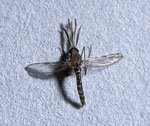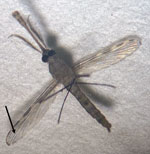Volume 28, Number 8—August 2022
Etymologia
Etymologia: Anopheles culicifacies
Anopheles culicifacies [′ə′ nɒfɨliːz′ kyü-lə cifā-sh(ē-)ēz]
In 1901, George Michael James Giles, a lieutenant-colonel and physician in the Indian Medical Service, described Anopheles culicifacies, which he collected from his guest house in Hoshangabad, India (Figure 1). This mosquito mimicked Culex spp. in facial appearance and resting posture (body angled to the surface they are resting on), prompting Giles to name it Anopheles culicifacies because of its culex (culici)‒like appearance (facies) (Figure 2).
An. culicifacies is the principle vector of malaria in India, contributing to >60% of malaria cases in this country annually. Therefore, ≈80% of the budget for malaria control in India is spent on control of this mosquito. Adults can be identified based on characteristic wing morphology (dark third vein) and palpi ornamentation (apical pale band is nearly equal to the pre-apical dark band).
Acknowledgment
I thank the Director of the National Institute of Malaria Research, Delhi, India, for providing encouragement to write this etymologia.
References
- Giles GM. Description of four new species of Anopheles from India. Entomol Mon Mag. 1901;37:196–8.
- Ramachandra Rao T. The anophelines of India. New Delhi: Oxford; 1984. p. 365–419.
Figures
Cite This ArticleOriginal Publication Date: July 08, 2022
Related Links
Table of Contents – Volume 28, Number 8—August 2022
| EID Search Options |
|---|
|
|
|
|
|
|


Please use the form below to submit correspondence to the authors or contact them at the following address:
Gaurav Kumar, India Council of Medical Research, National Institute of Malaria Research, Sector 8, Dwarka, Delhi, India
Top